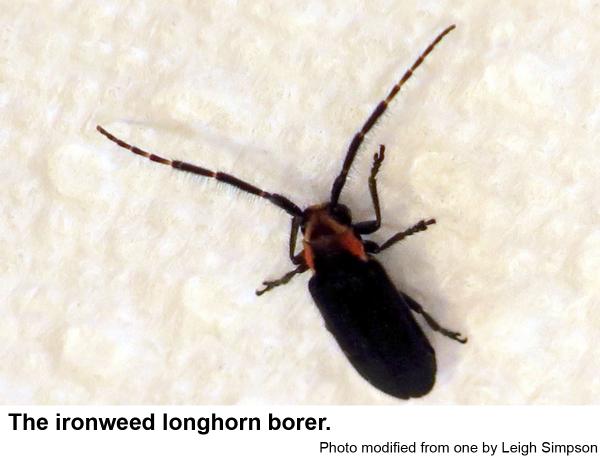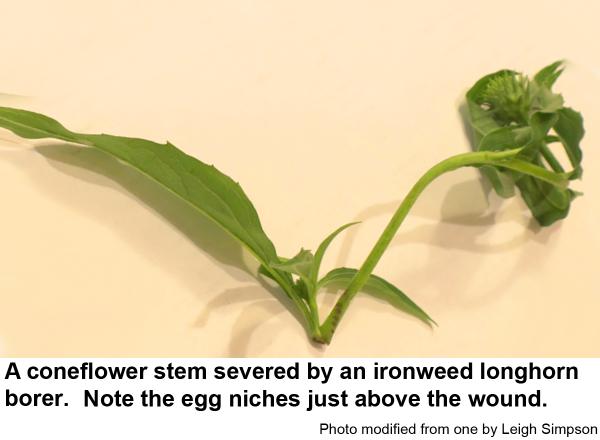Description and Biology
The ironweed longhorn borer, Hemierana marginata, is a small (almost 1/2 inch long), very dark beetle with antennae longer than the whole insect. It has an orange patches on either side of the thorax that continue onto the head sometimes forming a "V." On some specimens, the orange patches extend onto the "shoulders" of the wings. The antennae are very dark and somewhat hairy. It is said to be a mimic of lightning beetles and netwinged beetles. Not much has been published on its biology, but like other stem-boring longhorned beetles, females chew holes in host plant stems in which they insert eggs one per stem. In Kansas, full grown larvae overwintered near the crown of the plant sealed in individual cells. Pupation occurred in April and May and new adults emerged in about 10 to 14 days. Adults were observed in June and larvae were found in ironweed stems about the middle of July. Grubs grow to about 5/8 inch long and are white with yellow heads and thoraces. The abdomen is likely noticeably segmented. Larvae develop and pupate inside the severed host stem. Pupae are less than 5/8 inch long and white when just molted. They likely become very dark as they mature. This beetle is in flight from May though August so that Echinacea, ironweed and perhaps other plants in the sunflower family may be attacked throughout the growing season.
Host Plants
Described by Fabricius in the 1798, for a long time entomologists didn't know what host the ironweed longhorn borer used. It has since been reported from ironweed, bloodwort, wingstem (Verbesina) and Echinacea.
Residential Recommendations
This insect probably has not acquired resistant to insecticides as it infests many wild plants that are never sprayed with pesticides. Several of the pesticides labeled for landscape use contain pyrethroids has active ingredients. Pyrethroids have a long residual life once applied to a plant. Besides being toxic to insects, they are also repellent to them. However, pyrethroids are toxic to fish, so don't spray them around fish pools and ponds. When used as directed, pyrethroids are toxic to insects but are not particularly hazardous to humans and pets. Several formulations of pyrethroids are available in most big box stores and garden centers. Look at the active ingredient listed in very small letters toward the bottom of the label. Those pesticides ending in "thrin" are pyrethroids. Be sure to follow the directions on the label for safe use, water the plants before treating, and apply the mixture when the plants are in the shade.
Other Resources
- Coleoptera Associated with Ironweed, Vernonia interior Small in Kansas. R. B. Schwitzgebel and D. A. Wilbur. 1942. Kansas Entomol. Soc. 15 (2): 37-44.
- Hemierana marginata marginata (sic) (Fabricius). Anonymous. 2019 (copyright). Florida Department of Agriculture and Consumer Services.
- Species Hemierana marginata. Elliott, L. et al. 2024 (update). BugGuide, Iowa State University, Dept. Plant Path., Entomol. and Microbiology.
- Extension Plant Pathology Publications and Factsheets
- Horticultural Science Publications
- North Carolina Agricultural Chemicals Manual
For assistance with a specific problem, contact your local N.C. Cooperative Extension Center.
This Factsheet has not been peer reviewed.
Publication date: Nov. 23, 2019
Reviewed/Revised: Sept. 10, 2024
Recommendations for the use of agricultural chemicals are included in this publication as a convenience to the reader. The use of brand names and any mention or listing of commercial products or services in this publication does not imply endorsement by NC State University or N.C. A&T State University nor discrimination against similar products or services not mentioned. Individuals who use agricultural chemicals are responsible for ensuring that the intended use complies with current regulations and conforms to the product label. Be sure to obtain current information about usage regulations and examine a current product label before applying any chemical. For assistance, contact your local N.C. Cooperative Extension county center.
N.C. Cooperative Extension prohibits discrimination and harassment regardless of age, color, disability, family and marital status, gender identity, national origin, political beliefs, race, religion, sex (including pregnancy), sexual orientation and veteran status.


